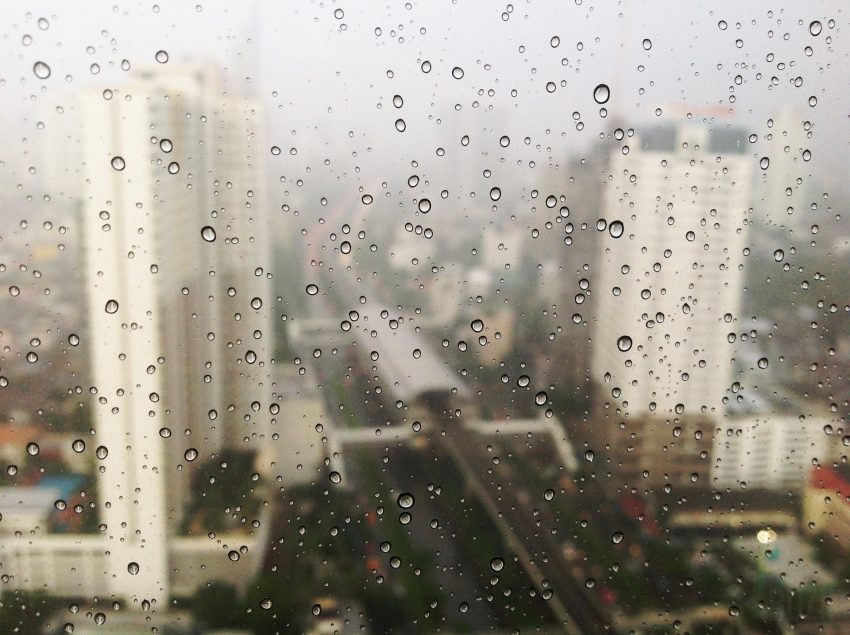What is condensation?
Condensation occurs when water vapour in the air comes into contact with cold surfaces like window panes and forms water droplets. Essentially, it’s the opposite reaction to evaporation – gas (vapour) turning to liquid (water droplets) instead of liquid (water) turning to gas (steam).
As condensation is caused by differences in temperature, you’re more likely to see the effects on colder days. The most common areas for condensation to form in your home is in the bathroom from the heat of showers and baths, or in the kitchen from cooking.

What effect can condensation have on your home?
Although water droplets on your windows may not seem like an issue, condensation can lead to some serious problems if it’s a common occurrence in your home..
Common issues caused by condensation include:
– Peeling wallpaper
– Damp furniture and surfaces
– Unpleasant smells
– Mould and damp
How to prevent condensation on windows
Condensation is something that occurs in all homes and although it can lead to problems, there are initiatives you can take to help combat the effects. To stop condensation on windows, there are three main steps to take: ventilation, insulation and clearing moisture.
1. Improving ventilation
By ensuring your home is properly ventilated, you’ll improve the airflow and fight off the issues caused by condensation.
Opening windows is a simple way to implement this, especially in the kitchen and bathroom. If you’ve cooked in the oven or on a hob, or if you’ve had a shower, leave your windows open in that room until the air is clear to prevent moisture build-ups.
It’s also important that you’re using extractor fans in both the kitchen and bathroom to allow steam to escape. Plus, keeping your doors closed helps to isolate steam and moisture, making it easier to dissipate and stops it spreading to other rooms.
2. Heating and insulation
Issues with condensation are intensified by sudden rises and drops in temperature, as each fluctuation causes water to evaporate and condense when your central heating turns on and off.
Rather than allowing your heating to swing between hot and cold, keep your heating on a constant low temperature. This will help to prevent damp from forming in your home.
Ensuring your home has appropriate insulation will reduce the likelihood of condensation forming in cold spots on walls and ceiling. Cavity wall and loft insulation will help to keep your walls a consistent temperature.
3. Clearing moisture
An immediate solution to condensation is to remove any water droplets you come across in your home.
All you need is a soft cloth or paper towels – something that won’t damage your windows – and you can keep on top of any moisture forming. In the short term, cleaning your windows of condensation regularly you can prevent the moisture developing in to damp or mould issues.
Read our full guide to maintaining your double glazing to find out proper cleaning and maintenance tips to keep your windows in great condition.
Tips on how to reduce condensation

As well as the larger preventative steps detailed above, there are also a number of smaller actions you can take to reduce the amount of condensation you produce at home.
1. Vented washer dryers
Many modern washer dryers are condenser models, which collect moisture from the drum which can be emptied later. If you have a vented washer dryer, however, make sure that the vent is properly secured; otherwise, moisture can easily escape and become trapped in your home.
2. Dry your clothes outside
If you have a garden, drying your clothes on a washing line is a really easy method of protecting your home from unnecessary moisture. If you live in an apartment or don’t have your own garden, keep a window open near your drying clothes with the doors closed to help the moisture escape from your home.
3. Cook with pot lids
Another easy way to reduce moisture in your home is to make sure you’re cooking with pot lids. Bubbling pots and pans release a lot of steam and moisture into kitchens, even with an extractor fan, so using a lid while you cook helps to reduce how much steam is released into the room.
4. Don’t overfill wardrobes and cupboards
Both wardrobes and kitchen cupboards are breeding grounds for mould if left overfilled. Any trapped moisture will struggle to escape due to the lack of airflow, so make sure you’re not filling them to the brim to allow air to circulate inside
5. Move furniture away from external walls
Just like with your wardrobes, it’s important to make sure there’s enough room between your walls and your furniture for air to circulate. If sofas and large pieces of furniture are pushed right up against walls, especially exterior walls, they run the risk of becoming damp and mouldy from the cold.
6. Use bath mats
It’s not just bathroom walls that have the potential for damp issues; the floor is at risk too. Invest in a good-sized bath mat to absorb most of the water when you get out of the bath or shower, so you’re not drenching your bathroom floor in water and creating more condensation.
7. Check for leaks
Keep an eye on your roof and ceilings for any drips or leaks that present themselves. They can be easy to miss at first, but if left unchecked, they can leave your ceiling and walls soaked over time.
8. Check guttering and downpipes
Much like leaks, blocked gutters can cause havoc to your exterior walls. Keep all guttering and downpipes free from debris to prevent blockages, which could lead to excess water soaking your homes exterior walls.
Condensation inside your double glazing
If you’ve noticed condensation inside your windows, it means your double glazing has failed. Whether due to faulty seals or poor installation, cloudy windows mean that moisture is getting in between the panes of glass, ruining the aesthetic of your windows and leading to bigger problems like mould and heat loss.
If you’ve noticed cloudy windows in your home, get in touch with your local branch of Cloudy2Clear, where our expert engineers will give you a free, no-obligation quote and will replace your failed double glazing – saving you time and money.
